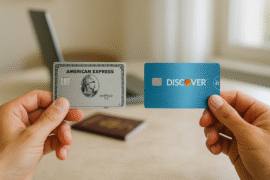This article may contain references to products or services from one or more of our advertisers or partners. We may receive compensation when you click on links to those products or services. Nonetheless, our opinions are our own.
The information presented in this article is accurate to the best of our knowledge at the time of publication. However, information is subject to change, and no guarantees are made about the continued accuracy or completeness of this content after its publication date.
- Key Highlights
- Understanding Buyer’s Remorse: The Emotional Impact of Impulsive Purchases
- Recognizing the Signs: When You Are Experiencing Buyer’s Remorse
- Buyer’s Remorse Data and Statistics
- Practical Strategies to Mitigate Buyer’s Remorse Before You Buy
- Legal Options and Consumer Protections
- Making Informed Decision: Research and Reflection Before Purchase
- Finding Clarity: How to Evaluate Purchases and Learn from Your Experiences
- Dealing with Buyer’s Remorse: Practical Solutions
- Frequently Asked Questions
- Recommended Reads
Key Highlights
- What Is Buyer’s Remorse? Buyer’s remorse is the regret or anxiety that follows a purchase, often because of impulsivity, high expectations, or financial concerns.
- Why Does It Happen? Common causes include emotional spending, social pressure, and dissatisfaction when a purchase doesn’t meet expectations.
- How Can You Prevent It? By implementing smart financial habits such as research, budgeting, and reflection before purchasing, you can minimize regret and make more confident buying decisions.
Understanding Buyer’s Remorse: The Emotional Impact of Impulsive Purchases
We’ve all been there—the thrill of a spontaneous purchase followed by that sinking feeling when reality sets in. Buyer’s remorse is a natural emotional reaction often arising when impulse buying leads to dissatisfaction or regret. It’s not just about the money spent; it can shake your confidence and make you question your financial decisions.
Common Cause of Buyer’s Remorse
- Impulsivity – Acting on a whim can cloud your judgment, leading to purchases that don’t align with your needs.
- Social Pressure – The need to keep up with friends or trends can push you into unnecessary purchases.
- High Expectations – Believing a purchase will bring happiness or solve a problem can lead to disappointment if it doesn’t meet expectations.
To mitigate these feelings, consider implementing a few strategies before making a purchase:
| Strategy | Description |
|---|---|
| Pause for Reflection | Take a day to think about your purchase. If you still want it after 24 hours, proceed cautiously. |
| Create a Budget | Allocate funds for discretionary spending to ensure purchases align with financial goals. |
| Seek Advice | Discuss with a trusted friend or family member to help assess the necessity of your purchase. |
Recognizing the emotional impact of buying decisions is the first step toward mindful spending and ensuring your money goes toward things that genuinely enhance your life.
Recognizing the Signs: When You Are Experiencing Buyer’s Remorse
Have you ever lay awake at night, second-guessing a recent purchase? Buyer’s remorse can manifest in different ways, and recognizing these signs early can help you take control of your financial decisions.
Common Signs of Buyer’s Remorse
- Feelings of unease or guilt – You regret spending the money and question if it was worth it.
- Hesitation to use the item – You avoid using the product, unsure whether you need it.
- Obsessively researching alternatives – You continue looking up better deals even after purchasing.
- Doubting your decision – Questions start swirling in your mind:
- Did I really need this?
- Could I have spent my money more wisely?
- Is this product even worth the cost?
If you often experience these feelings, it may be time to refine your decision-making process to prevent unnecessary regret.
Buyer’s Remorse Data and Statistics
Buyer’s remorse is a common phenomenon many people experience after purchasing. The emotional impact of buying decisions can lead to feelings of unease, guilt, and doubt about the value of the item bought. Recognizing these signs early is crucial in managing your finances wisely.
Research shows that buyer’s remorse affects a significant percentage of consumers. Studies indicate that up to 50% of people have felt regret after making a purchase. This highlights the importance of avoiding impulsive buying and being mindful of your spending habits.
Practical Strategies to Mitigate Buyer’s Remorse Before You Buy
To curb post-purchase regret, adopt proactive strategies before making a decision.
Research Before You Buy
- Compare products – Check different options to ensure you get the best value.
- Read reviews – Look for genuine customer experiences to gauge product reliability.
- Check the seller’s reputation – Avoid scams and ensure quality by purchasing from reputable retailers.
Implement a Cooling-Off Period
Set a waiting period before buying, such as 24 to 48 hours, to give yourself time to reconsider the purchase. This mental pause helps you determine if the purchase is essential or just a fleeting desire.
Set Clear Spending Boundaries
- Set a budget – Define how much you’re willing to spend.
- List priorities – Separate needs from wants.
- Consult someone – Talk with a trusted friend or family member for support and perspective.
Tracking your purchases at a simple table can help you evaluate your spending habits:
| Item | Value | Purchase Date | Regret Level |
|---|---|---|---|
| Smartphone | $800 | 09/01/2023 | Low |
| Designer Bag | $400 | 09/05/2023 | High |
| Gym Membership | $600/year | 09/10/2023 | Medium |
By thoughtfully preparing, you can foster confidence in your purchases and minimize post-transaction anxiety.
Legal Options and Consumer Protections
Knowing your legal options and consumer protections can provide a sense of security when faced with buyer’s remorse. Many jurisdictions offer remedies such as refund policies, warranties, and cooling-off periods for certain types of purchases. Understanding these safeguards can empower you to address any regrets and seek resolution when needed confidently. Remember, being informed is key to navigating the post-purchase experience effectively.
Making Informed Decision: Research and Reflection Before Purchase
Purchasing without proper research can lead to regret, but a little preparation can help you avoid this pitfall.
Steps to Make an Informed Decision
- Do Your Homework – Look for reviews, watch videos, and read articles to understand the product’s performance and reliability.
- Compare Prices – Use price comparison websites and apps to find the best deal.
- Reflect on Your Needs – Ask yourself if the purchase aligns with your long-term goals.
Asking the right questions can enhance your decision-making process:
| Question | Consideration |
|---|---|
| How often will I use this? | Determine the frequency of use to assess its actual value. |
| Can I afford this without impacting my budget? | Ensure the purchase won’t strain your finances. |
| What do others say about it? | Read reviews and testimonials from those who have made the same purchase. |
Combining research with personal reflection significantly reduces the chances of buyer’s remorse, helping you make purchases that truly enrich your life.
Finding Clarity: How to Evaluate Purchases and Learn from Your Experiences
Taking a moment to reflect on your buying habits can make a significant difference in your financial well-being.
Questions to Ask Yourself Before Buying
- Do I need this item? – Does it serve an immediate need or contribute to long-term goals?
- How will this affect my budget? – Will it impact your financial stability?
- What do others say? – Are reviews and experiences from other buyers positive?
Tracking your past purchases can help you identify patterns and reduce buyer’s remorse:
| Item | Cost | Value (1-10) | Regret Level (1-10) |
|---|---|---|---|
| Gadget | $120 | 7 | 3 |
| Clothing | $60 | 5 | 8 |
| Subscription Service | $15/month | 6 | 2 |
Reflecting on your purchasing patterns helps you distinguish between genuine value and momentary excitement, leading to more satisfying buying decisions in the future.
Dealing with Buyer’s Remorse: Practical Solutions
When faced with buyer’s remorse, there are practical steps you can take to address the situation and prevent it from happening again.
- Return or Exchange—If possible, consider returning or exchanging the item you regret. Many retailers have flexible return policies to help ease the regretful purchase’s financial burden.
- Learn from the Experience – Use the situation as a learning opportunity. Reflect on what led to the purchase and how you can avoid similar pitfalls in the future.
- Practice Mindful Buying – Before making a purchase, take a moment to pause and evaluate whether it aligns with your needs and values. This mindful approach can help prevent impulse buying and reduce the chances of buyer’s remorse creeping in.
- Build a Considered Shopping List – Make a list of items you truly need or have been saving up for. Stick to this list while shopping to avoid unnecessary purchases driven by fleeting desires.
- Seek Alternative Satisfaction – Instead of relying on retail therapy, explore other activities that bring you joy and fulfillment with no material possessions.
Frequently Asked Questions
What is buyer’s remorse?
Buyer’s remorse is the feeling of regret or anxiety that follows a purchase. It often occurs after a significant financial commitment, such as buying a car, a house, or high-end electronics.
What causes buyer’s remorse?
Several factors contribute to buyer’s remorse, including impulsive decisions, social pressure, and financial strain. Emotional influences, like pressure from salespeople or excitement over a new purchase, can also lead to regret.
How can I recognize the signs of buyer’s remorse?
Signs of buyer’s remorse include persistent doubt about your decision, the urge to return or sell the item, and financial anxiety post-purchase. If you frequently second-guess your purchases, you may be experiencing buyer’s remorse.
How can I avoid buyer’s remorse?
To minimize buyer’s remorse, follow these strategies:
- Conduct thorough research before making a purchase.
- Make a pros and cons list to evaluate your options.
- Set a waiting period (24-48 hours) before deciding.
- Establish a clear budget and stick to it.
Is buyer’s remorse a common experience?
Yes, buyer’s remorse is common, especially for significant purchases. Many people experience uncertainty after spending a large amount of money. Understanding that it’s routine can help ease some discomfort.
What should I do if I experience buyer’s remorse?
If you experience buyer’s remorse, take a step back to assess the situation:
- Reflect on why you feel regret.
- Consider returning or reselling the item if possible.
- Learn from the experience and apply those lessons to future purchases.
By refining your spending habits and decision-making strategies, you can reduce buyer’s remorse and confidently make purchases.

Reviewed and edited by Albert Fang.
See a typo or want to suggest an edit/revision to the content? Use the contact us form to provide feedback.
At FangWallet, we value editorial integrity and open collaboration in curating quality content for readers to enjoy. Much appreciated for the assist.
Did you like our article and find it insightful? We encourage sharing the article link with family and friends to benefit as well - better yet, sharing on social media. Thank you for the support! 🍉
Article Title: Buyer’s Remorse: How to Stop Regretting Your Purchases
https://fangwallet.com/2025/03/02/buyers-remorse/The FangWallet Promise
FangWallet is an editorially independent resource - founded on breaking down challenging financial concepts for anyone to understand since 2014. While we adhere to editorial integrity, note that this post may contain references to products from our partners.
The FangWallet promise is always to have your best interest in mind and be transparent and honest about the financial picture.
Become an Insider

Subscribe to get a free daily budget planner printable to help get your money on track!
Make passive money the right way. No spam.
Editorial Disclaimer: The editorial content on this page is not provided by any of the companies mentioned. The opinions expressed here are the author's alone.
The content of this website is for informational purposes only and does not represent investment advice, or an offer or solicitation to buy or sell any security, investment, or product. Investors are encouraged to do their own due diligence, and, if necessary, consult professional advising before making any investment decisions. Investing involves a high degree of risk, and financial losses may occur including the potential loss of principal.
Source Citation References:
+ Inspo
There are no additional citations or references to note for this article at this time.












































